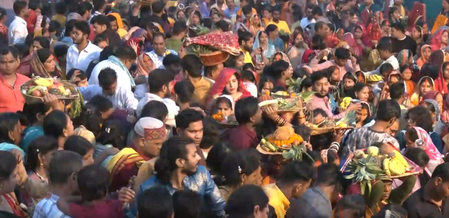New Delhi — The four-day Chhath Puja festival concluded on Tuesday with the sacred ‘Usha Arghya’, as devotees across India offered prayers to the rising sun, expressing gratitude to Lord Surya and Chhathi Maiya. The ritual marked the end of one of Hinduism’s most austere and spiritually significant festivals.
The final offering, known as ‘Usha Arghya’, symbolizes hope, renewal, and thankfulness. As the first rays of the morning sun illuminated rivers, ponds, and ghats, devotees stood waist-deep in water, chanting hymns and mantras while seeking blessings for health, happiness, and prosperity.
In Delhi, elaborate security and crowd management arrangements were in place. At ITO’s Hathi Ghat, the atmosphere was serene yet vibrant, with medical camps, CCTV surveillance, and dedicated help desks ensuring a safe celebration.
Though deeply rooted in Bihar, eastern Uttar Pradesh, and Nepal, Chhath Puja has in recent years gained nationwide popularity, drawing participation in cities such as Delhi, Mumbai, Ahmedabad, and even across southern India.
BJP National Spokesperson Pradeep Bhandari joined the devotees in Delhi, praising the festival’s message of unity and devotion. A local participant shared, “The arrangements this year are excellent. Everything is peaceful, and we are truly happy with the facilities provided.”
In Patna’s AG Colony, hundreds of devotees gathered before dawn with offerings of fruits, sugarcane, and traditional sweets like thekua placed in bamboo baskets. Union Minister Dharmendra Pradhan, who joined the rituals there, said, “I feel truly blessed to offer prayers to Lord Surya and Chhathi Maiya. The faith and energy of the fasting devotees are inspiring.”
At Sangam Vihar Ghat in Delhi, chants of “Jai Chhathi Maiya” filled the air as families performed rituals together. In Bihar, LJP (Ram Vilas) MP Shambhavi Choudhary and Union Minister Chirag Paswan also participated in the concluding ceremonies. Paswan said, “Chhathi Maiya has blessed us with happiness and strength. We wish for every family in a developed Bihar to live with joy and prosperity.”
Across the country, similar scenes of devotion were witnessed — from Ayodhya, where devotees assembled from 3 a.m., to Varanasi, where the Ganges ghats glittered with thousands of diyas. Celebrations also took place in Rajasthan’s Kotputli, Gujarat’s Ahmedabad, Jharkhand’s Ranchi, and Odisha’s Bhubaneswar. Odisha Chief Minister Mohan Charan Majhi joined devotees and extended his greetings.
The four-day festival begins with Nahay Khay, a ritual bath and simple meal. The second day, Kharna, involves a day-long fast broken with offerings of rasiya (sweet porridge) and roti. On the third day, devotees perform Sandhya Arghya (evening offering) and observe a nirjala vrat (fast without water) until dawn of the final day, Usha Arghya, when prayers are offered to the rising sun to conclude the festival.
With inputs from IANS


